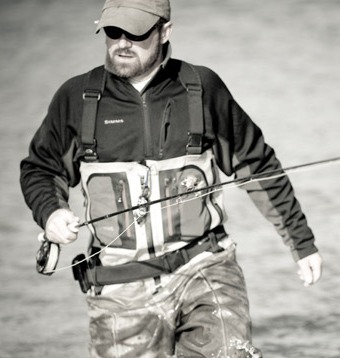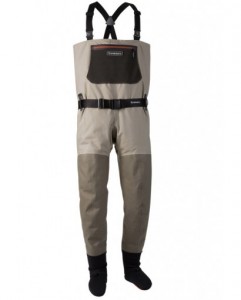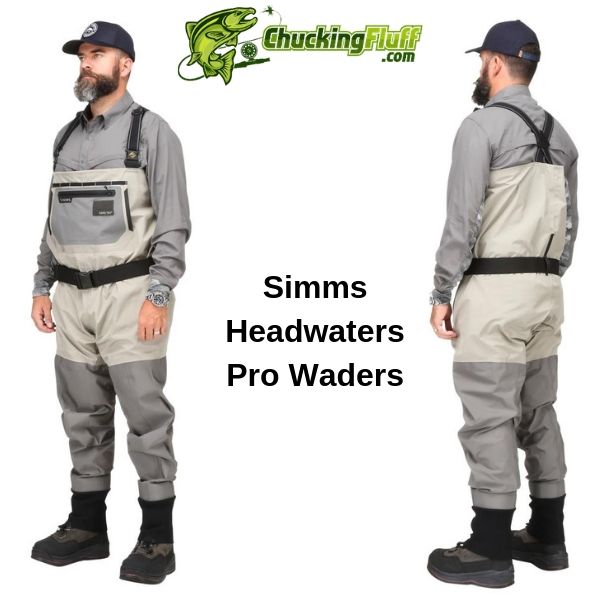| Disclosure: Just to be open and honest the buttons and links you click on in the website will in most cases take you to another website where you can purchase the products I am reviewing. As an Amazon Associate I earn from qualifying purchases. |
Benefits of Breathable Chest Waders for Fly Fishing
While fishing especially fly fishing it is always a good idea to wade in the water. This does come with the responsibility to check if the water is wadeable, for instance the bottom is within reach and not too rocky to make it dangerous. If the conditions are safe then wading does a number of things to help with your fly fishing and in this post we will discuss the benefits of breathable chest waders for fly fishing as well as other types of waders.
Quick Post Navigation
So why do we need waders anyway?
When fly fishing there are numerous hazards on the banking when casting, therefore, entering the water gives the angler the ability to avoid these. Waders will allow you to follow the river downstream through a pool or beat without having to move around trees or other hazards which takes time and can affect your catch rates.
The other benefit is that while fly fishing you need to cover trout to induce a take. Wading allows you to move about to cover these trout better especially in rivers where

wading out into the middle of the river will allow the fly to swim around in the current and sit on the dangle better for trout sitting midstream.
The dangle is when the cast has completely swum around in the current to its holding position before the retrieve. This is only relevant in rivers because in still waters the cast will be straight out where you placed it and will not move very much.
Some people think wading will disturb trout and this is true if you are like a bull in the china shop but if you are careful and move stealthily trout will pass by very close to you. I have on many occasions been soaked by a trout that has jumped feet from me when I was in stealth mode.
What types of waders are available on the market today?
There are numerous types some with combinations of materials but the main ones are:
- PVC
- Nylon
- Rubber
- Neoprene
- Breathable
If we discuss the differences in these we find that PVC, nylon, rubber and neoprene can make you sweat, are usually heavy and have the boot connected to the wader so you have less options on grip. The cheaper PVC and nylon ones are usually very slippery on rocks and river moss and need great care taken when negotiating the river or lakeside.
Some of the neoprene waders come with different boot grips and are not as slippery but can be very heavy in relation to the PVC or nylon. All four are fairly tough and take a bit of rough wear but care needs to be taken as leaks can still occur. Fixing such leaks is usually straightforward as a simple patch glued over the hole will suffice.
As these materials are all fairly stiff washing is not easy and they do become very smelly after a while. Life span with moderate wear and care could be up to 3 years.
The breathable chest wader option!
Breathable chest waders are much more expensive compared to the previous four types but do come with more benefits. They are made from breathable materials that allow body moisture to get away from the body to keep you dry longer.
This depends on your activity in the waders as running a marathon will have you soaking from sweat as you would expect. Some anglers used to complain about their waders leaking when in fact it was just the walk from the car to the river on a warm day was all it took to create a bit of a sweat. Then as they cooled they felt the dampness and put it down to leaks but when we checked the waders they were in fact waterproof.
Breathable chest waders are very light and allow you to fish so much longer as you are not carrying an awful lot of extra weight. They come with extra pockets and D rings for attaching equipment and some of the better ones usually have a waterproof inner pocket for your phone and car keys, etc.

You can easily wash them in a bath or large bucket but make sure you don’t use detergent as this will affect the waterproof system. Instead, use warm clean water and gently wash them for a few minutes before rinsing in clean water.
Breathable chest waders might leak, primarily because the pores become blocked or affected by silt and dirt from the river. Washing in this fashion will remove the dirt, leaving the pores to breathe freely again. As an additional cleaning stage, you can wash your waders with MiraZyme to deodorize them and have them smelling fresh again.
The other great benefit of breathable chest waders is the ability to have a change of footwear. This prolongs the life of the waders as its usually the footwear that goes first when walking over rocky river beds for hours at a time. If your boots fail you can always replace them and your good to go again. This is much cheaper than having to replace the whole wader. With stocking foot waders there are a lot of different types of wading boot to go with them which we will discuss that in another post.
So how do breathable chest waders work?
A breathable chest wader allows the fabric to transfer water vapor away from the body. At the same time, its waterproofness prevents water droplets from actually penetrating the fabric.
Is it good, therefore, that water vapor is a lot smaller than water droplets. It can move easily through a mesh, while water cannot. This means you stay dry even when walking moderately. As stated earlier if you sweat too hard some of that vapor combines to form water droplets which now cannot leave the wader and is trapped in with you so you feel wet.
There are a few tests to see how waterproof a fabric is, one, the hydrostatic pressure is measured with a column of water 1cm2 pushing down on the fabric with a result of 1000mm being ample for a jacket for lite summer showers. Larger results are required for waders with Gore-Tex usually giving figures above 20,000mm.
Most waders now come built with layers with some of the most expensive having five or more layers built into them. These help keep the water vapor transfer from falling back into the body of the wader and against you. The extra layers can add to the weight and flexibility of the wader so there is a trade off however the top brands have made some great products that keep you dry and fishing all day.
Cons of breathable chest waders
The waders are very light and used in winter days they require a base layer to keep you warm. Although wader manufacturers have designed extra clothing to wear under waders which are very comfortable and do a great job in keeping you warm it does add to the cost so for someone starting out this can become very expensive.
I myself have been fishing in -6°C ( 21°F) with breathable chest waders, a pair of base layer leggings, a fleece bib and brace suit and didn’t feel any cold even though I was up to my waist in water. In fact the only part of me that was cold was my stripping finger as it was un-gloved. 🙂
Breathable chest waders are very easy to damage when knocked against thorns or rocks and extra care is required to keep them leak-free.
When putting on breathable waders for fly fishing care has to be taken so you do not pull the stitching as this will also produce leaks. If you are in anyway un-flexible getting a pair of chest waders on can be difficult. There are options available that come with zips that go down the front and these help with this situation but I have heard of anglers going to relieve themselves and then forgetting to zip up again and getting waders full of water so be careful if you go for these. 🙂
Don’t forget to check out the post on breathable wader accessories there is more to using them than you might think.
Summary
Cons
- PVC, Rubber – Sweaty, heavy, inflexible, connected boot, slippery
- Neoprene – Sweaty, heavy, inflexible, connected boot, seams get damaged putting on
- Breathable – Cold in winter, easily damaged, seams get damaged putting on
Pros
- PVC, Rubber – Leaks easily repaired, tough
- Neoprene – Choice in boot grip available, tough
- Breathable – Lite, flexible, easily washed, leaks easily repaired, non-sweaty



How does the foot stay dry if it’s only a stocking with a boot over.
Mark your foot is in a stocking attached to the wader completely encased in neoprene which is waterproof. The boot is to protect the stocking foot from the river bed.
Hi Mark – A novice lady fisher and at present restricted by wearing thigh waders but with good studded grip. As a fell walker I am used to the Goretex material and to be quite honest do not feel my jackets (well looked after) do not prevent leakage after a short time in heavy rain therefore am concerned re usage in rivers.
I have previously used a neoprene wet suit for water skiing and found it to be comfortable and warm. I do not want attached boots as would prefer to buy boots with studs. I know quite a number of fishermen whose waders leak.
My problem with the rubber waders I use is barbed wire unseen until too late punctured the fabric leaving me with a wet leg/foot. I am looking for something tough that will withstand the wire and other farm debris buried in the banks of the riverside and am not sure even with your good comments whether to buy neoprene or breathable.
Fishing is expensive to start and do not want to waste my saved up money on the wrong thing. Help clear my mind!
The problem with barbed wire is there is not a pair of waders manufactured that can withstand them. Hard steel wire will puncture the most resistant hard wearing brands. The good thing about small puncture holes is that they are easily fixed with a patch and some stormsure.
Being mindful on the river and careful where you trek will aid the life of a pair of waders but sure as the sun is going to set you will get a leak.
That is my problem with rain gear also is the breathability of the suit….you need the breathability…without I know I will sweat a river in un-breathable gear…
Have not worn hip wader too many times but I have and the comfortableness from the heat build up was terrible just terrible…breathable gets my vote….
Need yourself some good gloves for the cold….:)
Sweating in gear then sitting about and getting cold can be a huge joy kill. 🙁
Have had to hike to a favorite spot on many occasions which had built up the moisture to find then when you get there you are soaked. Then you sit about in wet gear to get a chill and feel uncomfortable not the nicest of days. If it wasn’t for the fishing we wouldn’t do it.
However changing to breathable chest waders means you can make the hike arrive fairly dry or become dry in no time and can enjoy the days fishing without feeling cold or damp.
Well worth spending a bit extra on the gear.
Very informative, Mark! If I’m ever in the market for waders, you’ve pretty much given me all the information I need to make an intelligent decision. It’s apparent you’re a more enthusiastic fisherman than I, for as I sit on the bank, you’re out there in mid-stream, actively pursuing the prize. Who knows, if you continue these helpful posts, I might just end up out there in the water myself. 🙂
Bill I get out in the water for a number of reasons.
1) To get around the vegetation that affects my back cast.
2) To be able to get my cast to swim around in the current to the feeding fish. More natural looking presentation.
3) I like to be active and you can see so much more mid-stream than tucked away on the banking.
So get yourself a pair of breathable chest waders and I’ll see you mid-stream. 🙂
Are there any waders in children sizes or do they come in adult size only? If so, which material is recommended for them to use? Thanks.
Hi Teresa there are indeed waders for children and they come in different materials. I think however as children are not as good at protecting the waders I would go for pvc or rubber ones and only up to the top of the thigh. Some suppliers do chest waders but I think that is a bit dangerous especially for young children.
I have a question – is it one layer of material that allows the vapor to escape but at the same time repels water, or are there two layers, ie one for vapor release and one for water repelling. I would think that vapor could not escape with the pressure from the water on the outside, but I’ve never used breathable chest waders so I’m not sure.
What kind of chest waders do you use most often?
Hi Nathaniell breathable waders come in different layering systems although the basic of models have only one membrane. Not sure about the physics of vapor transfer but I would assume the vapor rises and leaves through the top of the wader which would normally be out of the water unless you are wading really deep.
I use breathable most often especially for fly fishing as I tend to be on the go all the time walking up and down bank sides etc to get to the next beat or pool and these help me stay cool.
I do own a pair of neoprene ones and pull them on for bank or boat fishing in colder days when the extra thickness from the neoprene adds comfort to sitting. However breathable with an under layer of fleece bib and brace do suitable as well but sitting in them can cause leaks so I tend not to do that using the older pair of neoprene ones.